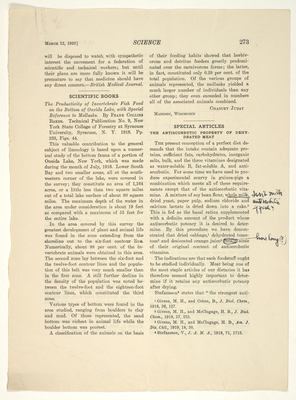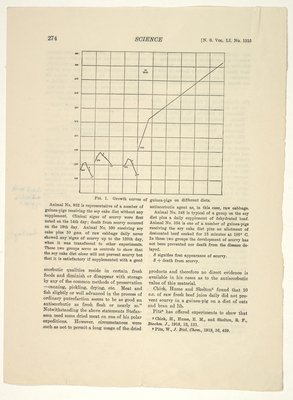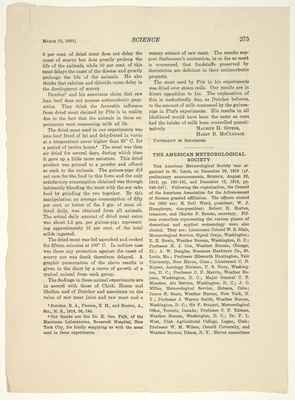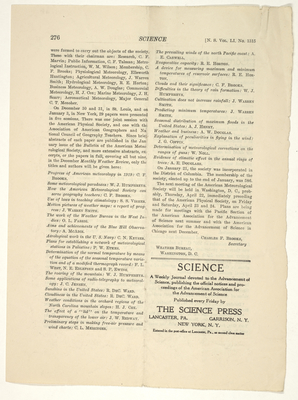Pages
stefansson-wrangel-09-40-008-001a
March 12, 1920]
SCIENCE
273
will be disposed to watch with sympathetic interest the movement for a federation of scientific and technical workers; but until their plans are more fully known it will be premature to say that medicine should have any direct concern.—British Medical Journal.
SCIENTIFIC BOOKS
The Productivity of Invertebrate Fish Food on the Bottom of Oneida Lake, with Special Reference to Mollusks. By Frank Collins Baker. Technical Publication No. 9, New York State College of Forestry at Syracuse University, Syracuse, N. Y. 1918. Pp. 233, Figs. 44.
This valuable contribution to the general subject of limnology is based upon a numerical study of the bottom fauna of a portion of Oneida Lake, New York, which was made during the month of July, 1916. Lower South Bay and two smaller areas, all at the southwestern corner of the lake, were covered in the survey; they constitute an area of 1,164 acres, or a little less than two square miles out of a total lake surface of about 80 square miles. The maximum depth of the water in the area under consideration is about 19 feet as compared with a maximum of 55 feet for the entire lake.
In the area covered by this survey the greatest development of plant and animal life was found in the zone extending from the shoreline out to the six-foot contour line. Numerically, about 88 per cent, of the invertebrate animals were obtained in this area. The second zone lay between the six-foot and the twelve-foot contour lines and the population of this belt was very much smaller than in the first zone. A still further decline in the density of the population was noted between the twelve-foot and the eighteen-foot contour lines, which constituted the third zone.
Various types of bottom were found in the area studied, ranging from boulders to clay and mud. Of those represented, the sand bottom was richest in animal life while the boulder bottom was poorest.
A classification of the animals on the basis
of their feeding habits showed that herbivorous and detritus feeders greatly predominated over the carnivorous forms; the latter, in fact, constituted only 0.29 per cent, of the total population. Of the various groups of animals represented, the mollusks yielded a much larger number of individuals than any other group; they even exceeded in numbers all of the associated animals combined.
Chancey Juday
Madison, Wisconsin
SPECIAL ARTICLES
THE ANTISCORBUTIC PROPERTY OF DEHYDRATED MEAT
The present conception of a perfect diet demands that the intake contain adequate proteins, sufficient fats, carbohydrates, inorganic salts, bulk, and the three vitamines designated as water-soluble B, fat-soluble A, and antiscorbutic. For some time we have used to produce experimental scurvy in guinea-pigs a combination which meets all of these requirements except that of the antiscorbutic vitamine. A mixture of soy bean flour, whole milkIsn't milk antiscobutic if fresh?, dried yeast, paper pulp, sodium chloride and calcium lactate is dried down into a cake.1 This is fed as the basal ration supplemented with a definite amount of the product whose antiscorbutic potency it is desired to determine. By this procedure we have demonstrated that dried cabbage,1 dehydrated tomatoes2 and desiccated orange juice3 retain how long? of their original content of antiscrobutic vitamine.
The indications are that each foodstuff ought to be studied individually. Meat being one of the most staple articles1 of our dietaries it has therefore seemed highly important to determine if it retains any antiscorbutic potency after drying.
Stefansson4 states that “ the strongest anti-
1 Givens, M. H., and Cohen, B., J. Biol. Chem., 1918, 36, 127.
2 Givens, M. H., and McClugage, H. B., J. Biol. Chem., 1918, 37, 253.
3 Givens, M. H., and McClugage, H. B., Am. J. Bis. CHI, 1919, 18, 30.
4 Stefansson, V., J. A. M. A., 1918, 71, 1715.
I
stefansson-wrangel-09-40-008-001b
274 SCIENCE [N. S. Vol. LI. No. 1315
Fig. 1. Growth curves of guinea-pigs on different diets.
Animal No. 932 is representative of a number of guinea-pigs receiving the soy cake diet without any supplement. Clinical signs of scurvy were first noted on the 14th day; death from scurvy occurred on the 19th day. Animal No. 390 receiving soy cake plus 30 gms. of raw cabbage daily never showed any signs of scurvy up to the 120th day, when it was transferred to other experiments. These two groups serve as controls to show that the soy cake diet alone will not prevent scurvy but that it is satisfactory if supplemented with a good
antiscorbutic agent as, in this case, raw cabbage.
Animal No. 348 is typical of a group on the soy diet plus a daily supplement of dehydrated beef. Animal No. 354 is one of a number of guinea-pigs receiving the soy cake diet plus an allotment of desiccated beef cooked for 15 minutes at 100° C. In these two groups the development of scurvy has not been prevented nor death from the disease delayed.
S signifies first appearance of scurvy.
S + death from scurvy.
scorbutic qualities reside in certain fresh foods and diminish or disappear with storage by any of the common methods of preservation —canning, pickling, drying, etc. Meat and fish slightly or well advanced in the process of ordinary putrefaction seems to be as good an antiscorbutic as fresh flesh or nearly so,” Notwithstanding the above statements Stefansson used some dried meat on one of his polar expeditions. However, circumstances were such as not to permit a long usage of the dried
products and therefore no direct evidence is available in his cases as to the antiscorbutic value of this material.
Chick, Hume and Skelton5 found that 10 c.c. of raw fresh beef juice daily did not prevent scurvy in a guinea-pig on a diet of oats and bran ad lib.
Pitz6 has offered experiments to show that
5 Chick, H., Hume, E. M., and Skelton, R. F., Biochm. J., 1918, 12, 131.
6 Pitz, W., J. Biol. Chem., 1918, 36, 439.
stefansson-wrangel-09-40-008-002a
March 12, 1920]
SCIENCE
275
5 per cent, of dried meat does not delay the onset of scurvy but does greatly prolong the life of the animals, while 10 per cent. of this meat delays the onset of the disease and greatly prolongs the life of the animals. He also thinks that calcium and chloride cause delay in the development of scurvy.
Dutcher7 and his associates claim that raw lean beef does not possess antiscorbutic properties. They think the favorable influence from dried meat claimed by Pitz is in reality due to the fact that the animals in those experiments were consuming milk ad lib.
The dried meat used in our experiments was lean beef freed of fat and dehydrated in vacuo at a temperature never higher than 65° C. for a period of twelve hours.8 The meat was then air dried for several days, during which time it gave up a little more moisture. This dried product was ground to a powder and offered as such to the animals. The guinea-pigs did not care for the food in this form and the only satisfactory consumption obtained was through intimately blending the meat with the soy cake food by grinding the two together. By this manipulation an average consumption of fifty per cent, or better of the 3 gm. of meat offered daily, was obtained from all animals. The actual daily amount of dried meat eaten was about 1.5 gm. per guinea-pig; representing approximately 15 per cent, of the total solids ingested.
The dried meat was fed uncooked and cooked for fifteen minutes at 100° C. In neither case was there any protection against the onset of scurvy nor was death therefrom delayed. A graphic presentation of the above results is given in the chart by a curve of growth of a typical animal from each group.
The findings in these animal experiments are in accord with those of Chick, Hume and Skelton and of Dutcher and associates on the value of raw meat juice and raw meat and a
7 Dutcher, R. A., Pierson, E. M., and Biester, A., Sci., N. S., 1918, 50, 184.
8 Our thanks are due Dr. K. Geo. Falk, of the Harriman Laboratories, Roosevelt Hospital, New York City, for kindly supplying us with the meat used in these experiments.
watery extract of raw meat. The results support Stefansson’s contention, in so fas as meat is concerned, that foodstuffs preserved by desiccation are deficient in their antiscorbutic property.
The meat used by Pitz in his experiments was dried over steam coils. Our results are in direct opposition to his. The explanation of this is undoubtedly due, as Dutcher believes, to the amount of milk consumed by the guineapigs in Pitz’s experiments. His results in all likelihood would have been the same as ours had the intake of milk been controlled quantitatively. Maurice H. Givens,
Harry B. McClugage University of Rochester
THE AMERICAN METEOROLOGICAL SOCIETY
The American Meteorological Society was organized in St. Louis, on December 29, 1919 (cf. preliminary announcements, Science, August 22, 1919, pp. 180-181, and December 12, 1919, pp. 546-547). Following the organization, the Council of the American Association for the Advancement of Science granted affiliation. The officers elected for 1920 are: R. DeC. Ward, president; W. J. Humphreys, vice-president; Robert E, Horton, treasurer, and Charles F. Brooks, secretary. Fifteen councilors representing the various phases of theoretical and applied meteorology were also elected. They are: Lieutenant Colonel W. R. Blair, Meteorological Service, Signal Corps, Washington; E. H. Bowie, Weather Bureau, Washington, D. C.; Professor H. J. Cox, Weather Bureau, Chicago, 111.; A. W. Douglas, Simmons Hardware Co., St. Louis, Mo.; Professor Ellsworth Huntington, Yale University, New Haven, Conn.; Lieutenant C. N. Keyser, Aerology Division, U. S. Navy, Washington, D. C.; Professor C. F. Marvin, Weather Bureau, Washington, D. C.; Major General C. T. Menoher, Air Service, Washington, D. C.; J. C. Millas, Meteorological Service, Habana, Cuba; James H. Scarr, Weather Bureau, New York, N. Y.; Professor J. Warren Smith, Weather Bureau, Washington, D. C.; Sir F. Stupart, Meteorological Office, Toronto, Canada; Professor C. F. Talman, Weather Bureau, Washington, D. C.; Dr. F. L. West, Utah Agricultural College, Logan, Utah; Professor W. M. Wilson, Cornell University, and Weather Bureau, Ithaca, N. Y. Eleven committees
stefansson-wrangel-09-40-008-002b
276
SCIENCE
[N. S. Vol. LI. No. 1315
were formed to carry out the objects of the society. These with their chairman are: Research, C. F. Marvin; Public Information, C. F. Talman; Metrological Instruction, W. M. Wilson; Membership, C. F. Brooks; Physiological Meteorology, Ellsworth Huntington; Agricultural Meteorology, J. Warren Smith; Hydrological Meteorology, R. E. Horton; Business Meteorology, A. W. Douglas; Commercial Meteorology, H. J. Cox; Marine Meteorology, J. H. Scarr; Aeronautical Meteorology, Major General C. T. Menoher.
On December 30 and 31, in St. Louis, and on January 3, in New York, 29 papers were presented in five sessions. There was one joint session with the American Physical Society, and one with the Association of American Geographers and Na tional Council of Geography Teachers. Since brief abstracts of each paper are published in the Jan uary issue of the Bulletin of the American Meteo rological Society, and more extensive abstracts, ex eerpts, or the papers in full, covering all but nine, in the December Monthly Weather Review, only the titles and authors will be given here:
Progress of American meteorology in 1919: C. F. Brooks. Some meteorological paradoxes: W. J. Humphreys. How the American Meteorological Society can serve geography teachers: C. F. Brooks. Use of laws in teaching climatology: S. S. Visher. Motion pictures of weather maps: a report of progress: J. Warren Smith. The worfc of the Weather Bureau in the West Indies: O. L. Fassig. Aims and achievements of the Blue Hill Observatory : A. McAdie. Aerological worlc in the U. S. Navy: C. N. Keyser. Plans for establishing a network of meteorological stations in Palestine: P. W. Etkes. Determination of the normal temperature by means of the equation of the seasonal temperature variation and of a modified thermograph record: F. L. West, N. E. Edlefsen and S. P. Ewing. The roaring of the mountain: W. J. Humphreys. Some applications of radio-telegraphy to meteorology: J. C. Jensen. Sunshine in the United States: R. DeC. Ward. Cloudiness in the United States: R. DeC. Ward. Weather conditions in the orchard regions of the North Carolina mountain slopes: H. J. Cox. The effect of a “lid” on the temperature and transparency of the lower air: J. W. Redway. Preliminary steps in malting free-air pressure and wind charts: C. L. Meisinger. The prevailing winds of the north Pacific coast: A. E. Caswell. Evaporative capacity: R. E. Horton. A device for measuring maximum and minimum temperatures of reservoir surfaces: R. E. Horton. Clouds and their significance: C. F. Brooks. Difficulties in the theory of rain formation: W. J. Humphreys. Cultivation does not increase rainfall: J. Warren Smith. Predicting minimum temperatures: J. Warren Smith. Seasonal distribution of maximum floods in the United States: A. J. Henry. Weather and business: A. W. Douglas. Explanation of peculiarities in flying in the wind: J. G. Coffin. Determination of meteorological corrections on the ranges of guns: W. Noll. Evidence of climatic effect in the annual rings of trees: A. E. Douglass.
On January 21, the society was incorporated in the District of Columbia. The membership of the society, elected up to the end of January, was 586.
The next meeting of the American Meteorological Society will be held in Washington, D. C., probably, Thursday, April 22, immediately preceding that of the American Physical Society, on Friday and Saturday, April 23 and 24. Plans are being made for meetings with the Pacific Section of the American Association for the Advancement of Science next summer and with the American Association for the Advancement of Science in Chicago next December.
Charles F. Brooks,
Secretary
Weather Bureau,
Washington, D. C.
SCIENCE
A Weekly Journal devoted to the Advancement of Science, publishing the official notices and proceedings of the American Association for the Advancement of Science
Published every Friday by
THE SCIENCE PRESS
LANCASTER, PA. GARRISON, N. Y,
NEW YORK, N. Y.
Entered in the post-office at Lancaster, Pa., as second class matter



